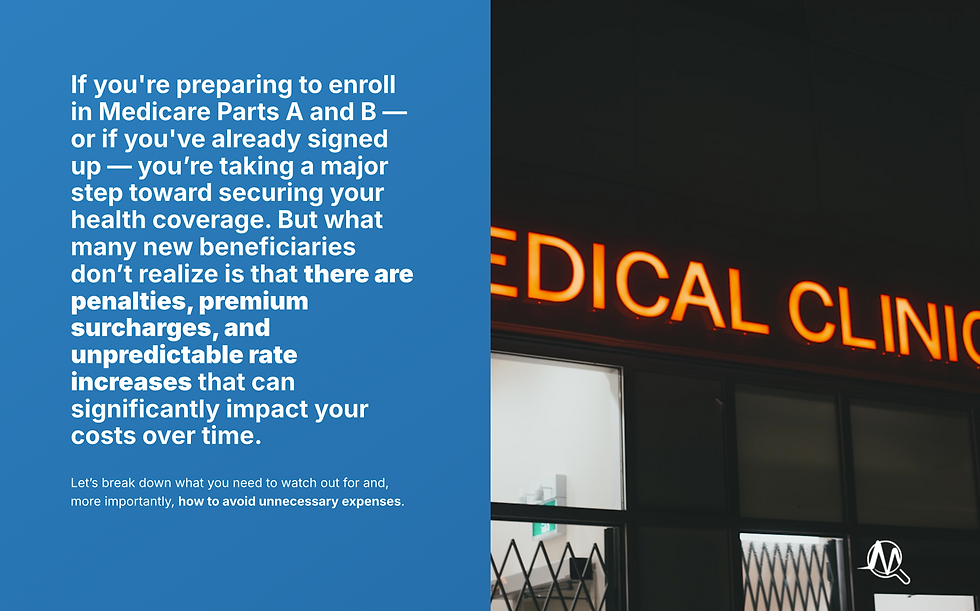Medicare Prescription Drug Coverage: Understanding Your Options with Part A and Part B
- Brice

- Jul 28
- 3 min read
Updated: Jul 28
If you’re getting ready to enroll in Medicare—or you already have Medicare Parts A and B—one of the next big decisions you’ll face is how to make sure your prescription drugs are covered.
Original Medicare (Parts A and B) covers hospital and medical care, but it does not include most prescription drugsyou take at home. Fortunately, you have a few different options to add drug coverage, depending on the type of Medicare package you choose. Let’s walk through the key pathways.
1. Pairing a Part D Plan with Original Medicare + Medigap
Many people choose to stick with Original Medicare (Parts A and B) and add a Medigap plan (also called Medicare Supplement insurance) to help pay some or all of the out-of-pocket costs that Medicare doesn’t cover, like deductibles, coinsurance, and copays.
But here’s the key point:Medigap plans do not include prescription drug coverage. If you go this route, you’ll need to enroll in a standalone Medicare Part D plan to cover your prescriptions.
What to Know:
Part D plans are sold by private insurers approved by Medicare.
You’ll choose a Part D plan that fits your prescription needs—different plans cover different medications, and costs vary.
Be sure to enroll when you’re first eligible, to avoid late enrollment penalties.
Medigap + Part D is a powerful combo for people who want predictable costs and broad provider access, since you can go to any doctor or hospital that accepts Medicare nationwide.
2. Using a Medicare Advantage Plan (Part C) Instead of Medigap
An alternative to the Original Medicare + Medigap + Part D setup is enrolling in a Medicare Advantage plan, also known as Part C.
Part C plans are offered by private insurers and bundle together your hospital (Part A), medical (Part B), and often prescription drug coverage (Part D) into a single plan.
What to Know:
Most Medicare Advantage plans include prescription drug coverage—these are known as MAPD plans.
You don’t need a separate Part D plan if your Part C plan includes drug coverage.
Medicare Advantage plans often come with extra benefits, like dental, vision, and hearing.
These plans usually require you to use a network of providers, and may require referrals for specialists.
So, if you opt for a Part C plan with drug coverage, it becomes a one-stop-shop for your Medicare needs—including prescriptions.
3. Prescription Drug Coverage for Dual-Eligible (Medicare + Medicaid) Individuals
If you have both Medicare and Medicaid, you’re considered dual-eligible, and you can also get help with prescription drug costs.
Here’s how it works:
Your hospital and doctor care will still be covered by Original Medicare (Parts A and B).
Medicaid helps pay for your Medicare premiums and cost-sharing (like deductibles and copays).
For prescription drugs, you’ll be automatically enrolled in a Medicare Part D plan (unless you choose one yourself).
What to Know:
You do not pay a Part D premium (or you pay a reduced amount), thanks to the Extra Help program.
You can switch Part D plans at any time during the year—not just during the Annual Enrollment Period.
Medicaid does not cover prescriptions that Medicare Part D covers—but it may cover some drugs that aren’t on your Part D plan’s formulary.
In some cases, people who are dual-eligible may enroll in a special Medicare Advantage plan called a Dual-Eligible Special Needs Plan (D-SNP) that bundles all services, including drug coverage, in one coordinated plan.
Bottom Line
No matter how you build your Medicare coverage, prescription drug coverage is a critical piece of the puzzle. Here’s a quick recap of your options:
Your Medicare Setup | How You Get Drug Coverage |
Part A + Part B + Medigap | Standalone Part D plan |
Medicare Advantage (Part C) | Most plans include drug coverage (MAPD) |
Medicare + Medicaid | Auto-enrolled or choose a Part D plan; may also join a D-SNP |
Understanding these paths helps you avoid coverage gaps and penalties—and ensures your medications stay affordable.
If you’re approaching your Initial Enrollment Period or thinking about switching coverage, this is a great time to review your medications and compare plan options. A licensed Medicare advisor or the Medicare Plan Finder tool at medicare.gov can help you sort through your choices based on the drugs you take and where you live.




















Comments